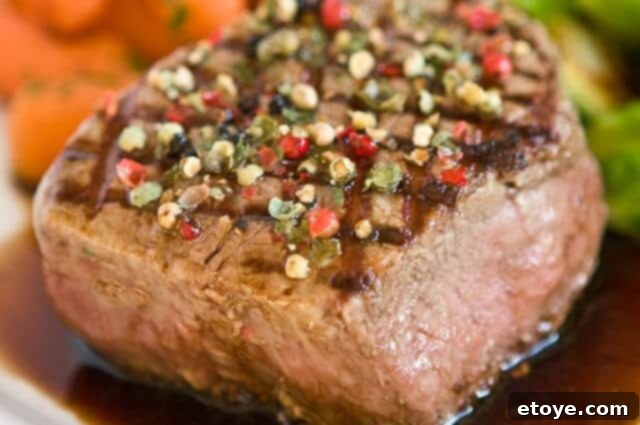
Mastering Filet Mignon: Your Guide to Trimming and Cooking Whole Beef Tenderloin
Filet mignon. The very name evokes images of luxurious dining, special celebrations, and an unparalleled melt-in-your-mouth tenderness. It stands as a pinnacle among steaks, and for excellent reasons. Sourced from the tenderloin, a muscle that bears no weight, it boasts a remarkably buttery texture and a subtle, sophisticated flavor that is truly exquisite. However, this premium cut typically commands a premium price, making it an occasional indulgence for many. What if you could savor this opulent steak more frequently, without the hefty cost? The secret lies in a smart culinary strategy: purchasing an entire beef tenderloin and skillfully preparing it yourself.
For individuals who value both superior quality and significant savings, learning the art of transforming a whole tenderloin into pristine filet mignon steaks is a transformative skill. This approach not only slashes the cost by as much as 50% compared to buying pre-cut steaks but also deepens your connection to the food you prepare. Imagine a freezer filled with perfectly portioned filet mignon, ready to elevate any impromptu gathering or simply to turn an ordinary weeknight into an extraordinary meal. It’s a culinary endeavor that offers immense satisfaction and tangible economic benefits.
The Butcher’s Advantage: Unlocking Value from Whole Beef Tenderloin
Our experience has shown that instead of procuring individual, often smaller, and considerably more expensive filet mignon portions, there is immense value in acquiring the entire tenderloin. This substantial primal cut, a muscular marvel roughly the size of a human forearm, holds the potential to yield numerous elegant steaks. To master this rewarding process, we sought guidance from Pat, the expert butcher at our local Sweetbay Supermarket. His professional insights have been invaluable, demonstrating that with a clear understanding and the correct techniques, anyone can convert a whole tenderloin into a treasure chest of gourmet steaks. Our collaboration with Sweetbay aims to inspire more people to discover and enjoy the superior quality of Black Angus Beef, proving that premium cuts can be surprisingly accessible when approached wisely.
The prospect of carving such a large piece of meat might initially seem intimidating, but Pat assures us it’s remarkably straightforward. In fact, compared to other massive cuts like a full rib roast, the tenderloin is quite manageable due to its elongated form and, true to its name, exceptional tenderness. The meat offers minimal resistance, making the carving process relatively easy on your hands. Furthermore, for those who prefer not to undertake the carving themselves, a helpful butcher at Sweetbay will gladly trim and cut your tenderloin for you, entirely free of charge. This convenient service further underscores the benefits of cultivating a relationship with your local butcher, who can be an excellent source for top-quality meats and expert culinary advice.

Step-by-Step Guide: How to Expertly Trim a Whole Beef Tenderloin
The journey to crafting perfect filet mignon steaks commences with the whole tenderloin, typically delivered in a vacuum-sealed package designed to preserve its shape and freshness. It is imperative to keep this packaging intact until you are fully prepared to begin the carving process. A critical initial tip for handling a whole tenderloin is to anticipate the natural juices that will have accumulated inside the bag. Before completely removing the tenderloin, we highly recommend snipping a small corner of the package and allowing any excess liquid or blood to drain directly into the sink. This simple measure significantly reduces mess and ensures a cleaner, more hygienic handling experience.
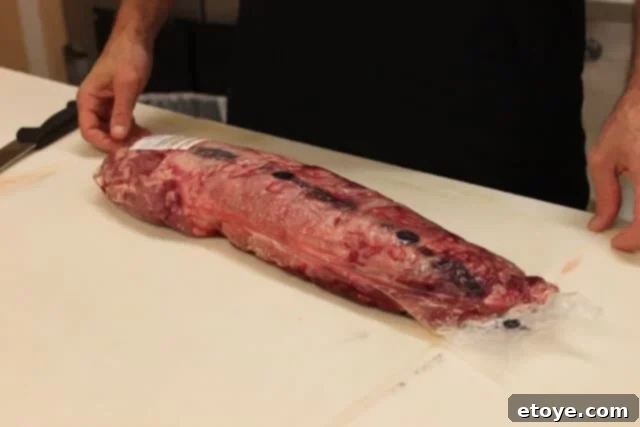
Once the tenderloin is unpacked, you will observe its distinct morphology: a thicker, larger end, often referred to as the “head” or “butt,” and a progressively thinner, smaller end, known as the “tail.” Our recommended carving approach begins at the larger end, where the most substantial and desirable filet mignon steaks are located. As you proceed towards the narrower end, the individual portions will naturally decrease in size. However, these smaller sections are far from wasted! You can elegantly tie two smaller pieces together with butcher’s twine to form a larger, more satisfying filet, or reserve them for alternative culinary applications. When the tenderloin becomes too slender to yield coherent individual steaks, Pat advises grinding the remainder along with any trimming scraps to create premium filet mignon ground beef. Alternatively, these tender, smaller morsels are perfectly suited for rapid-cooking dishes such as vibrant stir-fries or a rich, comforting beef stroganoff, guaranteeing that every precious part of this exquisite cut is utilized.
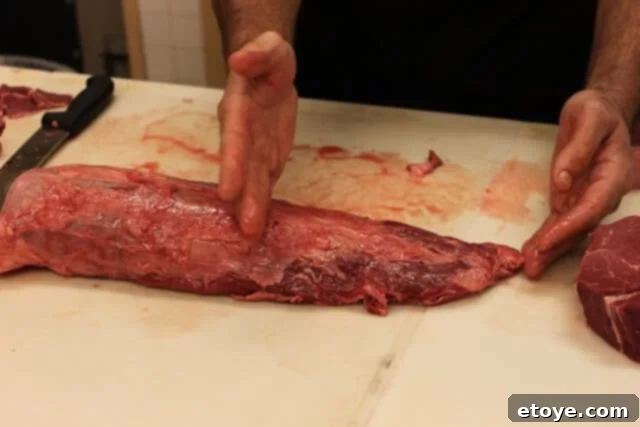
Precision Slicing and the Golden Rule of Post-Slice Trimming
Pat initiates the process by meticulously cutting slices approximately 1¾ inches thick from the larger end of the tenderloin. This specific thickness is ideal for achieving a substantial filet mignon steak that cooks beautifully to a perfect medium-rare, ensuring a succulent, juicy interior and a perfectly seared, flavorful crust. While 1¾ inches is a professional recommendation, you possess the flexibility to customize the thickness according to your personal preference; thinner cuts will cook more rapidly, whereas thicker ones will allow for a more pronounced rare center. The paramount objective is to maintain consistency in your slices to guarantee uniform cooking results.

As you execute your initial cuts, you will inevitably observe a layer of external fat and a thin, iridescent membrane—commonly referred to as silver skin—encircling the magnificent red meat. This is precisely where Pat imparted his most invaluable lesson, a technique that profoundly transformed my personal carving approach. My previous attempts invariably involved trimming both the fat and silver skin from the *entire tenderloin* prior to slicing it. This method proved to be excessively messy, resulted in considerable waste of valuable meat, and was far more physically demanding. Pat unequivocally demonstrated the superior technique: first, portion all your individual filet mignon steaks, and *then* proceed to trim each steak individually. This strategic sequence not only conserves time but also significantly minimizes waste and streamlines the trimming process, making it considerably cleaner and more efficient.
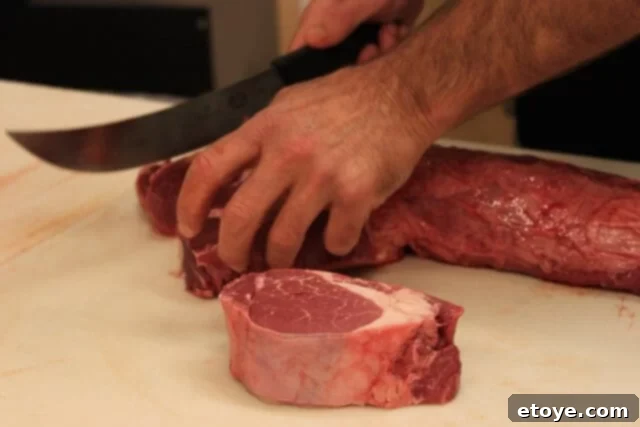
With all the steaks now precisely portioned, Pat meticulously undertakes the trimming of each one. This crucial step involves carefully excising the majority of the external fat and, most importantly, the tough, inedible silver skin. Silver skin is a dense connective tissue that, unlike fat, does not render or break down during the cooking process. If left intact, it can cause the steak to curl unattractively and become unpleasantly chewy. A sharp, flexible boning knife is the ideal tool for this delicate task, allowing you to expertly maneuver beneath the silver skin and gently separate it from the tender meat with minimal product loss. The ultimate objective is to achieve a clean, perfectly sculpted filet, immaculately prepared for seasoning and cooking.

The transformation is truly remarkable. What began as a large, irregularly shaped cut of meat has now been converted into a collection of exquisitely formed, substantial filet mignon steaks. Each cut is uniform, proudly displaying the lean, ruby-red muscle that renders this steak so highly coveted. This efficient method consistently yields impressive, generously portioned steaks that would command a significantly higher price at any specialty butcher shop or upscale restaurant. The profound satisfaction derived from achieving such professional-caliber results within your own kitchen is genuinely unparalleled, making the effort profoundly rewarding.
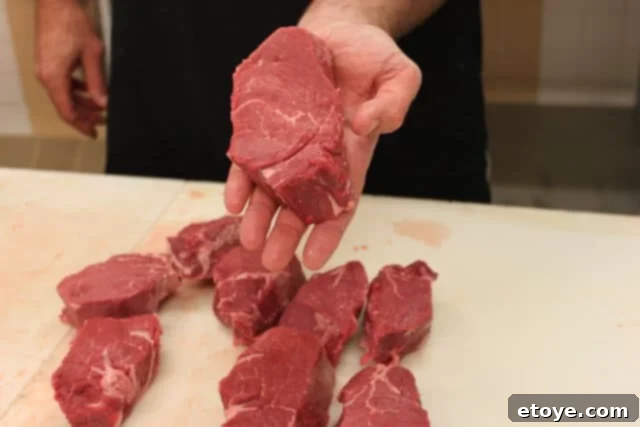
From a single whole tenderloin, we successfully yielded nine magnificent 1¾-inch thick filet mignon steaks. This substantial output emphatically illustrates the incredible value proposition of purchasing and trimming the entire cut. Each of these precisely cut steaks stands as a testament to both the superior quality of the beef and the efficiency of the trimming process, promising an exceptional dining experience. With these beautifully prepared steaks at hand, you are perfectly equipped for several exquisite meals, whether for personal enjoyment or for sharing with appreciative family and friends.
Maximizing Your Investment: Creative Uses for Leftover Tenderloin Scraps

One of the most brilliant advantages of trimming your own tenderloin is the inherent ability to utilize every single piece, thereby truly maximizing your culinary investment. The leftover scraps – which include both the carefully trimmed external fat and the smaller, irregular pieces unsuitable for individual steaks – are far too valuable to be discarded. As Pat wisely suggests, these can be passed through a meat grinder to produce the absolute finest quality ground beef imaginable. This is no ordinary ground beef; it is ground beef derived from filet mignon trimmings, guaranteeing an incredibly lean, intensely flavorful, and luxuriously tender product. If a meat grinder is not accessible, or if you simply prefer a different texture, these scraps can be easily cut into smaller, uniform, bite-sized pieces. These morsels are absolutely perfect for a quick and elegant stir-fry, adding a touch of gourmet sophistication to a weeknight meal, or for simmering in a rich, hearty stroganoff or a slow-cooked beef stew.
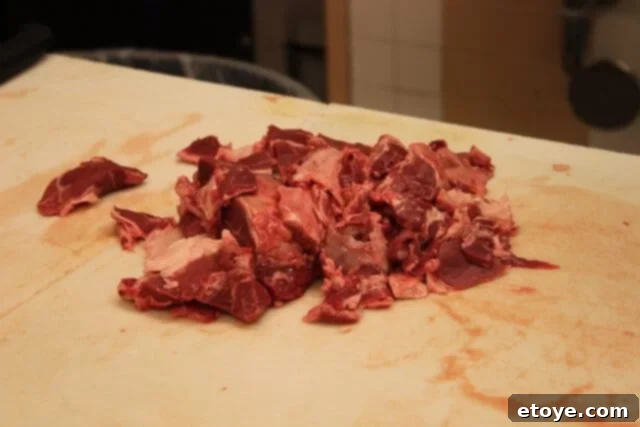
By feeding the carefully collected scraps into the grinder, we were able to produce an impressive four pounds of what can only be described as the very best filet mignon ground beef. This truly exceptional product offers a gourmet upgrade to a myriad of everyday dishes. While its inherently lean nature means it might require additional binders for traditional burgers or meatballs, it excels in numerous other culinary preparations. Imagine savory Asian Lettuce Cups bursting with flavor, a rich and deeply satisfying chili, or even an elevated shepherd’s pie. The intense beefy flavor and remarkably tender texture of this ground beef elevate any recipe it graces. This unexpected and generous bonus further solidifies the compelling economic and culinary advantages of buying a whole tenderloin. We have not only secured a freezer brimming with individual filet mignon steaks – each meticulously sealed individually for optimal preservation – but also a substantial supply of premium ground beef. This entire process resulted in nearly 50% savings, delivering both luxury and practicality in one harmonious endeavor.
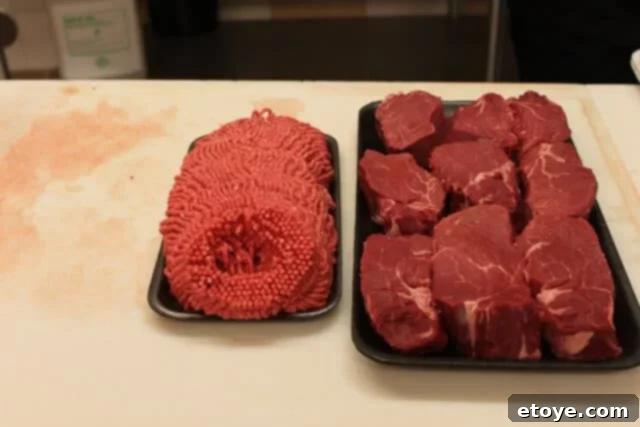
Peppercorn Crusted Filet Mignon with Balsamic Red Wine Sauce
Having invested the time to meticulously trim a whole tenderloin and prepare exquisite filet mignon steaks, it’s only fitting to cook them in a way that truly celebrates their exceptional quality. This recipe for Peppercorn Crusted Filet Mignon with Balsamic Red Wine Sauce is designed to do exactly that. While its sophisticated name might suggest a complex dish reserved for fine dining establishments, the reality is delightfully straightforward. This recipe requires only a handful of common ingredients and a mere 20 minutes of active cooking time, allowing the inherent, delicate flavor and tender texture of the filet mignon to shine through. It’s the perfect preparation to showcase your freshly cut steaks, transforming them into a show-stopping meal with minimal effort and maximum impact.
Servings: 4
Ingredients
- 2 tablespoons butter
- 1/2 cup balsamic vinegar
- 1/4 cup red wine
- 1/2 cup beef broth
- Salt, to taste
- 3 tablespoons whole peppercorns
- 1 tablespoon cooking oil
- 4 pieces Filet Mignon (at least 1¼” inch thick)
Instructions
- Preheat your oven to 400°F (200°C). Prepare a baking sheet by lining it with parchment paper or foil for easy cleanup, and set aside for the steaks.
- Begin preparing the Balsamic Red Wine Sauce. In a small saucepan, combine the butter and balsamic vinegar. Heat this mixture over medium heat until the balsamic begins to bubble gently. Reduce the heat to medium-low and allow it to simmer for approximately 3 minutes, or until the vinegar has visibly reduced by half. This crucial step concentrates its rich flavor and natural sweetness.
- Into the saucepan, add the red wine and the beef broth. Continue to simmer the sauce for an additional 5-8 minutes, or until it achieves a consistency thick enough to lightly coat the back of a spoon. Taste the finished sauce and season it with salt as needed, adjusting to perfectly balance the flavors. Set the sauce aside, keeping it warm if possible until ready to serve.
- Prepare the peppercorn crust. Evenly spread the whole peppercorns on a clean baking sheet or a sturdy cutting board. Using the bottom of a heavy-duty skillet or a meat mallet, gently crush the peppercorns. Apply firm, rocking pressure with the base of the skillet rather than a direct smash, aiming for a coarse, cracked texture, not a fine powder.
- Thoroughly pat each filet mignon dry with paper towels to ensure a superior sear. Lightly rub each steak with the cooking oil, ensuring even coverage. Generously season both sides of each filet with salt. Then, firmly press both sides of the seasoned filet mignon onto the crushed peppercorns, ensuring an even and substantial coating that adheres well to the meat’s surface.
- Heat a large, oven-proof skillet (a cast-iron skillet is highly recommended for its excellent heat retention) over high heat until it is extremely hot, just shy of smoking. Carefully place the peppercorn-crusted filet mignon into the searing hot skillet. Sear each side for precisely 1 minute, creating a beautiful, dark, and flavorful crust.
- After completing the searing, carefully remove the skillet from the heat. Transfer the seared filet mignon steaks from the skillet to the prepared baking sheet (it is perfectly acceptable if some crushed peppercorns remain on the baking sheet from step 4).
- Immediately place the baking sheet containing the seared steaks into the preheated 400°F (200°C) oven. Roast for 4-7 minutes, with the exact duration depending on your desired level of doneness and the specific thickness of your filet mignon.
- For optimal doneness and precision, always use a reliable meat thermometer:
- For a 1-inch thick filet mignon, begin checking the internal temperature after 4 minutes of roasting.
- Add approximately 1 minute of additional cooking time for every extra ¼-inch of steak thickness.
- Rare: 120-125°F (49-52°C)
- Medium-Rare: 130-135°F (54-57°C)
- Medium: 140-145°F (60-63°C)
- Once the steaks have reached your preferred level of doneness, remove them from the oven and allow them to rest undisturbed on a cutting board or plate for a minimum of 3 minutes. This critical resting period permits the internal juices to redistribute evenly throughout the meat, guaranteeing every bite is exceptionally tender and flavorful.
- Serve the perfectly cooked Peppercorn Crusted Filet Mignon immediately, generously drizzled with the warm Balsamic Red Wine Sauce. Enjoy your magnificent gourmet creation!
By investing a small amount of time and embracing the straightforward techniques shared by experienced butchers, you can fundamentally transform the way you enjoy filet mignon. This comprehensive guide has demonstrated how purchasing a whole beef tenderloin can lead to substantial financial savings, provide your freezer with a generous supply of perfectly portioned steaks, and even yield premium ground beef from the remaining trimmings. It’s an empowering culinary journey that elevates your home cooking to new heights and allows you to savor gourmet quality without the associated gourmet price tag. Embark on this delicious adventure and discover the profound satisfaction of mastering the art of the tenderloin!
